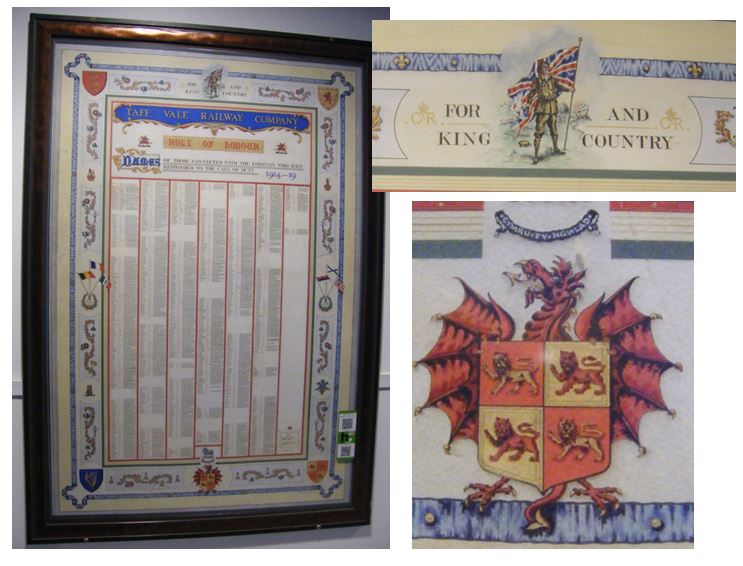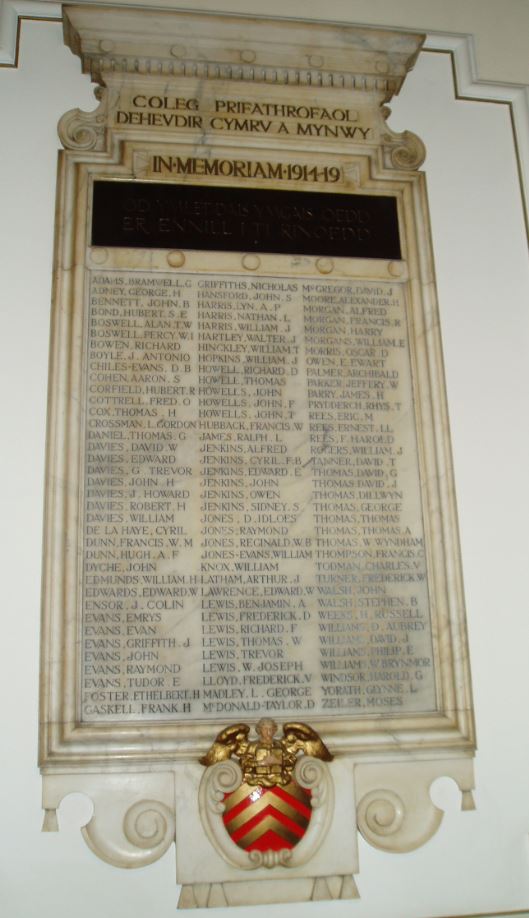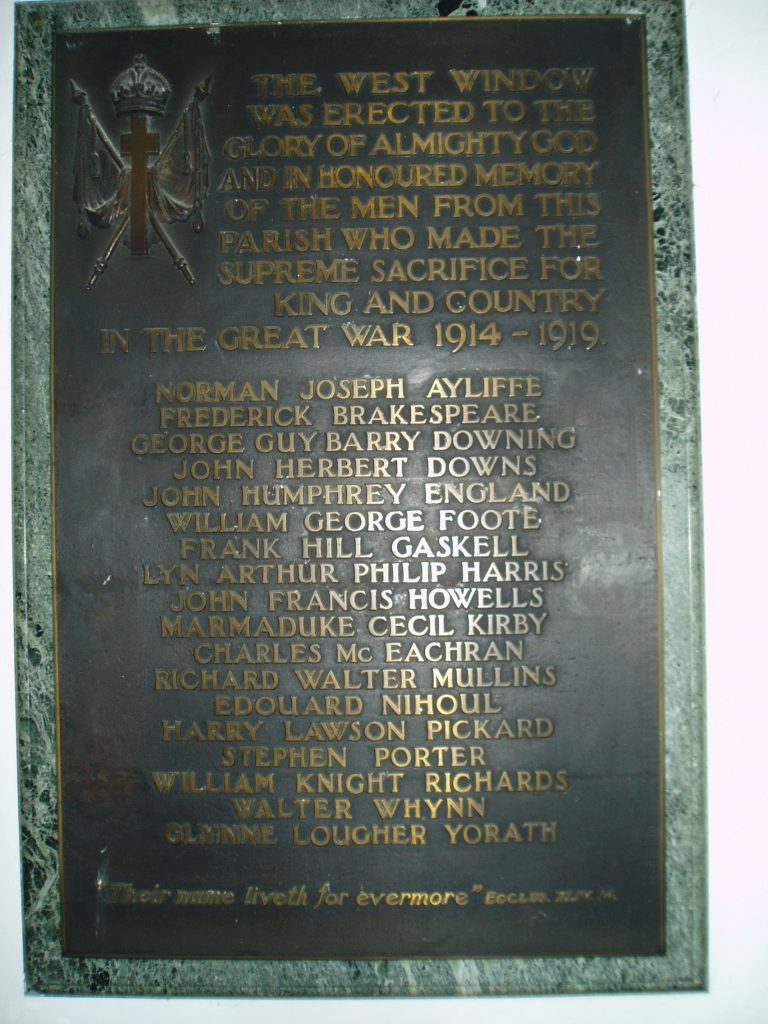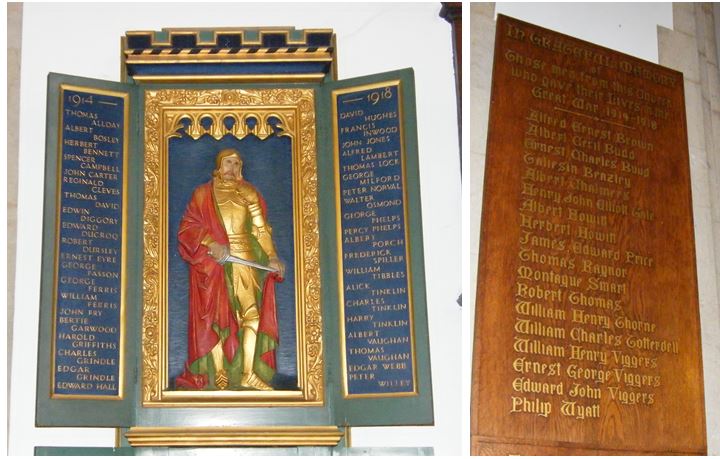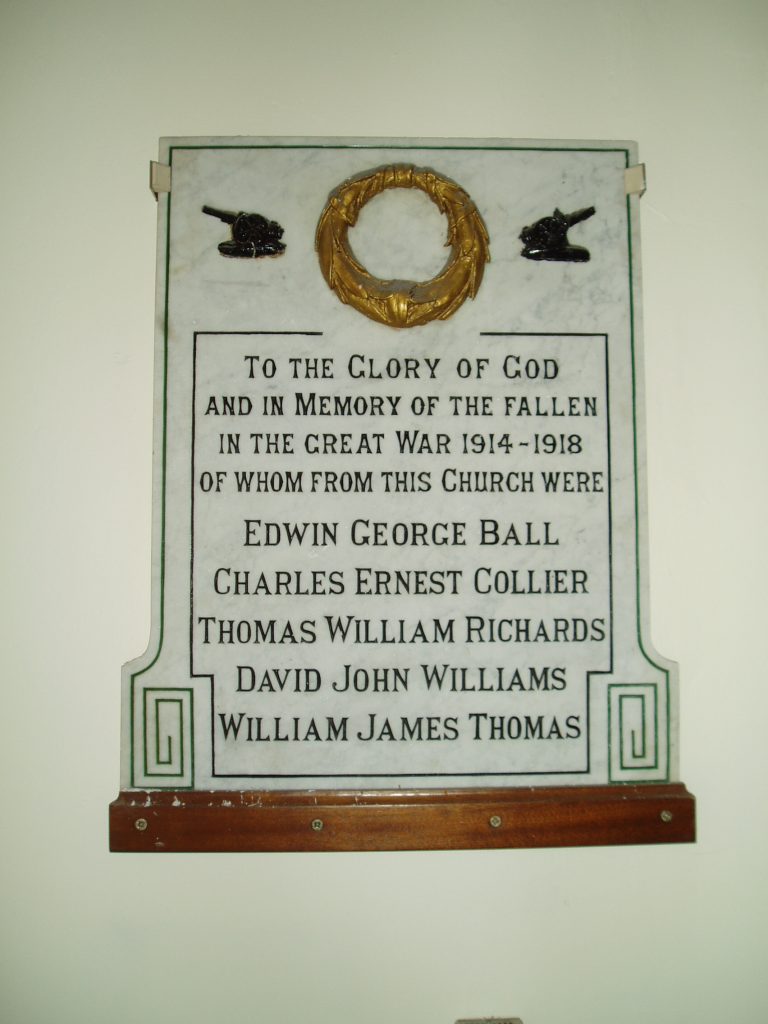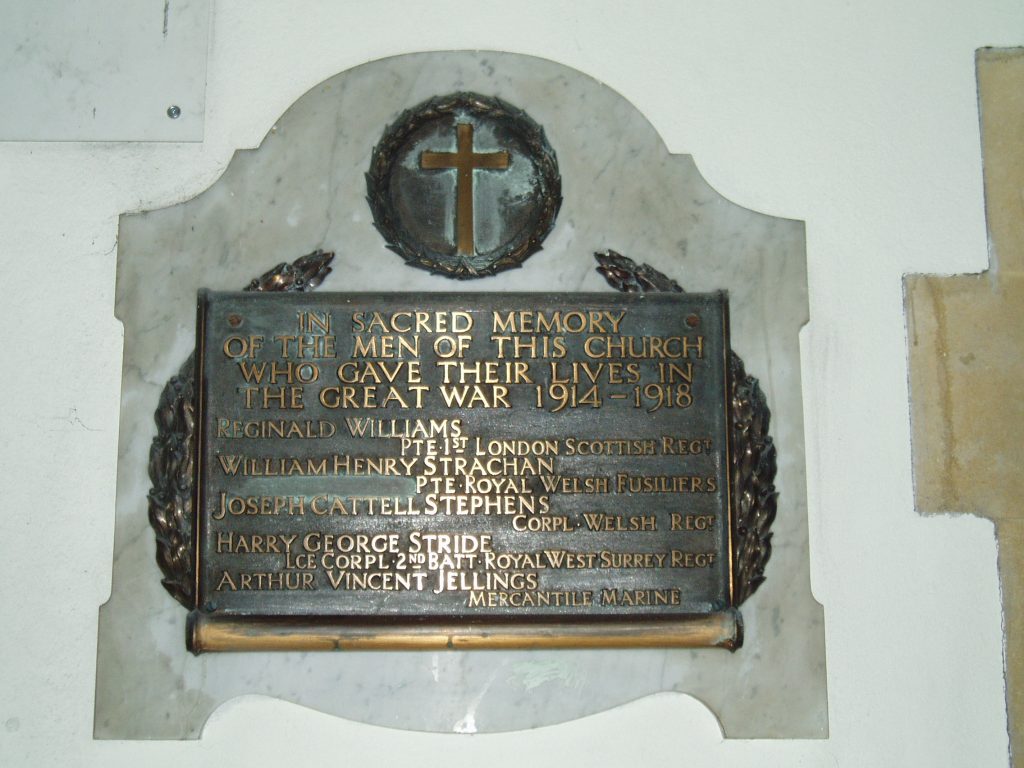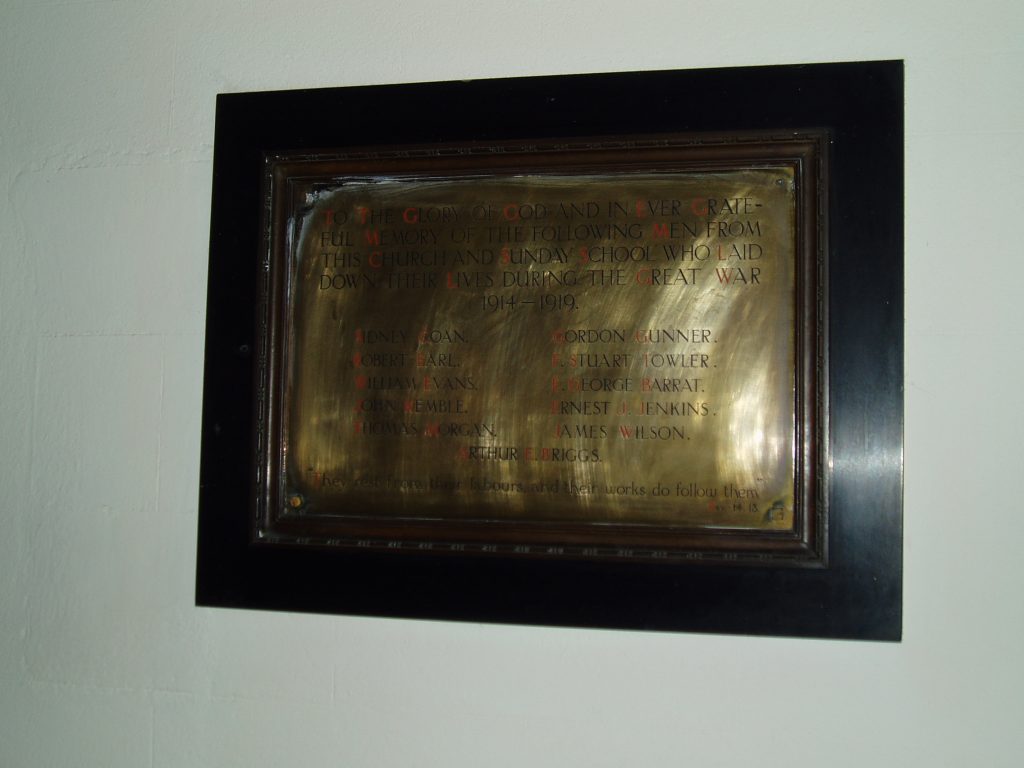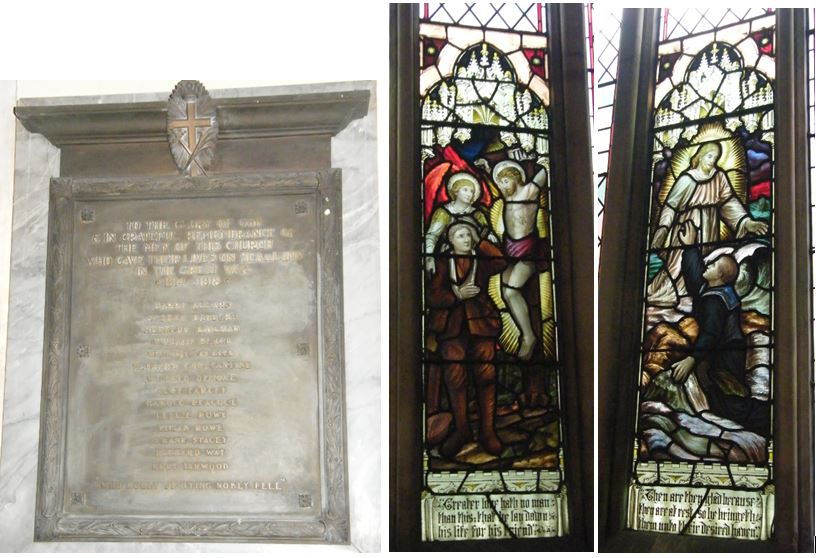Twenty First World War Memorials in Cardiff
There are literally hundreds of war memorials in Wales’ capital. In fact there are over a hundred memorials to the First World War in the city. These range from the enormously impressive Welsh National Memorial in Cathays Park to modest brass tablets.
This blog will concentrate not on the numerous visible memorials that can be seen in the city centre and in various suburbs, but on ones that are within buildings, and which thus may not be generally known even by those who live locally.
Looking in depth at the names on these memorials, you will find that some individuals are named on numerous ones. One rather exceptional example is the rugby player John Lewis Williams, a captain with the 16th Btn (Cardiff City) of the Welsh Regiment, who was badly wounded on the first day of the Battle of Mametz Wood, and died of his wounds on 12 July 1916. He is commemorated on the memorials in Whitchurch, St Mary’s Church, Whitchurch, Cardiff Coal Exchange, Cowbridge Grammar School, Penarth, Cardiff Masons, the WRU and Newport Athletic (Rugby) Club. (For further information, see Ceri Stennett and Gwyn Prescott’s book In Proud and Honoured Memory).
Works memorials
Cardiff is home to four of the most visually striking works memorials in Wales. The enormous memorial to the employees of Cardiff Corporation who served in the war is probably the one that takes the top prize.
Designed by Fred J Dobbs and printed by the Western Mail, it contains a wealth of visual imagery, as well as the names of around 600 employees who served (including at least eleven women). There are images of the flags of the Allies, the pyramids, of destruction in Belgium and of the Lusitania.
This memorial is in the grand surroundings of City Hall.
Another one which comes close in its visual impact is the memorial to the men of the Cardiff Railway company, located in the Pierhead Building in Cardiff Bay. This enormous memorial has the company crest and logo, and emblems symbolising the nations of the United Kingdom. There are almost 700 names inscribed upon it.
The Taff Vale Railway also commissioned a memorial to their employees who served. This is another ornate design and a detailed copy of it can be seen in the busy Queen Street station. (Further information here)
The fourth large-scale works memorial to be featured here is that to the Post Office workers of Cardiff. This lists over 600 names, of whom over 40 died : it can be seen in the customer service centre in the Royal Mail’s Penarth Road depot. (Further information here)
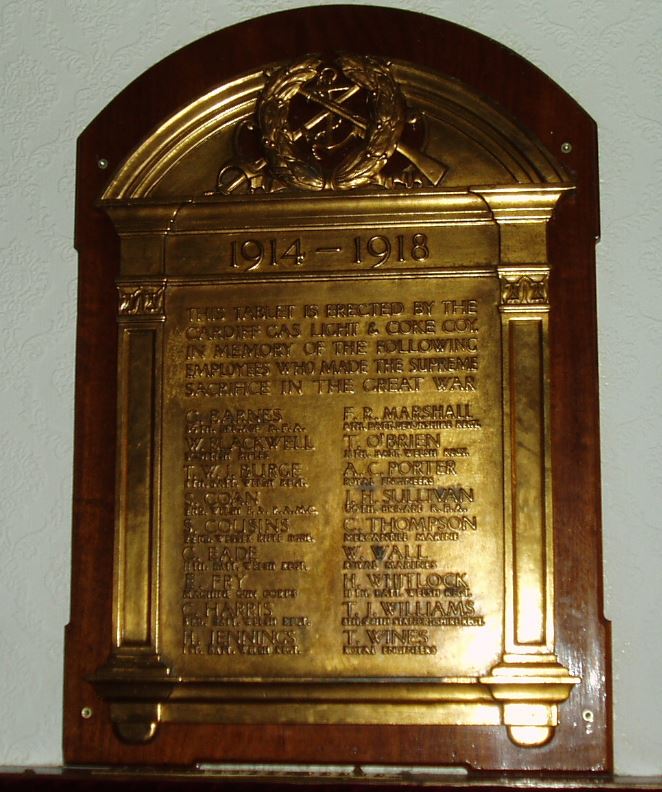 A number of smaller workplaces around Cardiff commissioned their own memorials. Given that so many companies that were in business then have now disappeared it is difficult to know how many have been lost. One that has survived is that of the Cardiff Gas Light And Coke Company Grangetown Works
A number of smaller workplaces around Cardiff commissioned their own memorials. Given that so many companies that were in business then have now disappeared it is difficult to know how many have been lost. One that has survived is that of the Cardiff Gas Light And Coke Company Grangetown Works
University and School memorials
As the war progressed many places of education had ‘rolls of honour’ listing former students who were serving in the forces. If anyone knows whether any of the local schools still have their ‘roll of honour’ (as opposed to a memorial to those who died) please let me know.
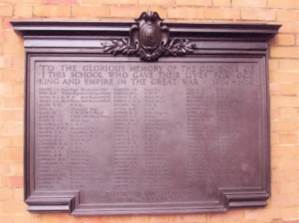 Many schools have relocated over the decades, but one which still has its WW1 memorial despite moving to a new site is Cardiff High School.
Many schools have relocated over the decades, but one which still has its WW1 memorial despite moving to a new site is Cardiff High School.
The University (then under the unwieldy name of the ‘University College of South Wales and Monmouthshire’) established a memorial to the 111 former undergraduates who were killed in the war.
Churches
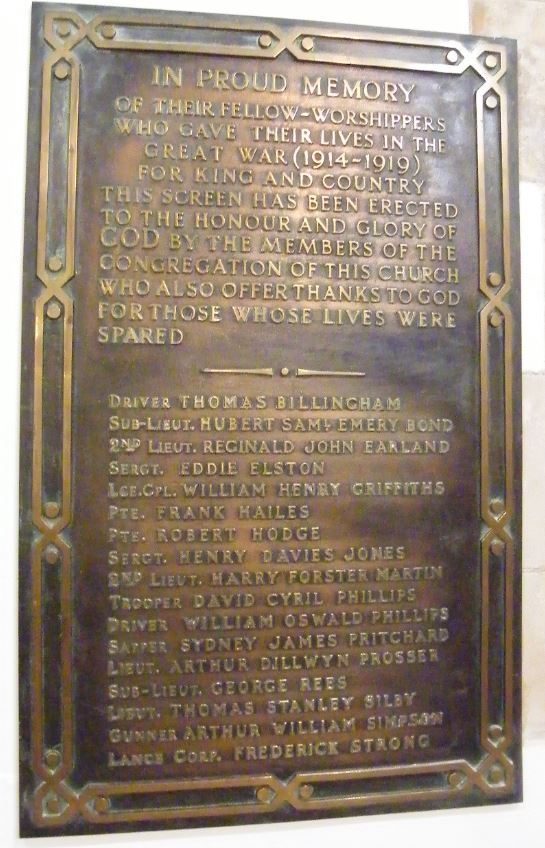 Most of the places of worship commissioned war memorials to those of their congregations who had died. Sometime these are brass plaques, of a simple design but with an emotional punch when you count the names on them. The memorial commissioned by the church of St James’ on Newport Road has 17 names on it. The church is now closed, so the plaque is on display in St John’s in the city centre.
Most of the places of worship commissioned war memorials to those of their congregations who had died. Sometime these are brass plaques, of a simple design but with an emotional punch when you count the names on them. The memorial commissioned by the church of St James’ on Newport Road has 17 names on it. The church is now closed, so the plaque is on display in St John’s in the city centre.
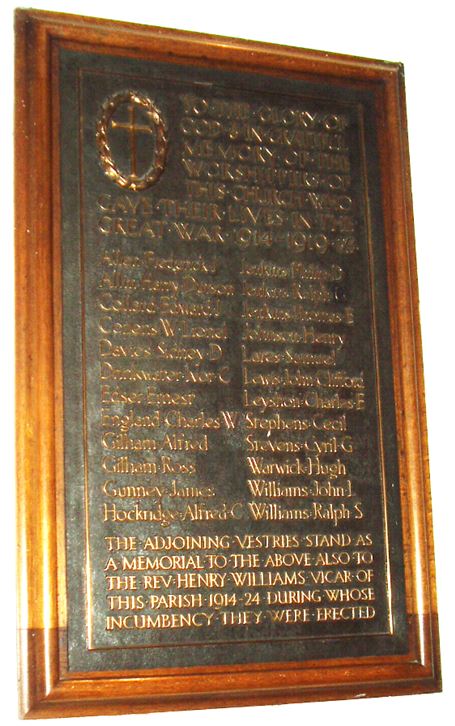 In the northern suburbs, one of Cardiff’s most impressive outdoor memorials is in Whitchurch, but there is also a memorial to the parishioners who attended St Mary’s church. This lists 24 names.
In the northern suburbs, one of Cardiff’s most impressive outdoor memorials is in Whitchurch, but there is also a memorial to the parishioners who attended St Mary’s church. This lists 24 names.
Also in the north of the city, the church of St Isan in Llanishen lists 18 men on its memorial.
Nearer the centre of the city is the impressive church of St German’s. This has not only a memorial to those of this church who died in WW1 (40 names), but also that of the congregation of St Agnes’ (18 names).
Chapels
The Anglican churches of Cardiff were far outnumbered by the Nonconformist chapels. Some of the memorials in these buildings are substantial, such as the one in Y Tabernacl in the Hayes, featured in a previous blog.
To begin with some more modest examples, there are five names on the memorial in Whitchurch Methodist church. Two of them (Charles Collier and David Williams) were killed in the Battle of Mametz Wood on 7 July 1916, serving with the ‘Cardiff Pals’.
There are also five names on the memorial in St Andrew’s United Reformed Church (then known as Roath Park Presbyterian). One, Joseph Stephens, was killed in the Battle of Doiran in northern Greece on 18 September 1918 alongside many other Cardiff men.
There are eleven names on the memorial in Heath Evangelical Church (then Heath Presbyterian).
The three examples above are all in buildings still active as places of worship. However a number of Cardiff’s chapels have closed down. In many such occasions the memorials inside have been moved; in others (and it is impossible to know how many) they have been lost.
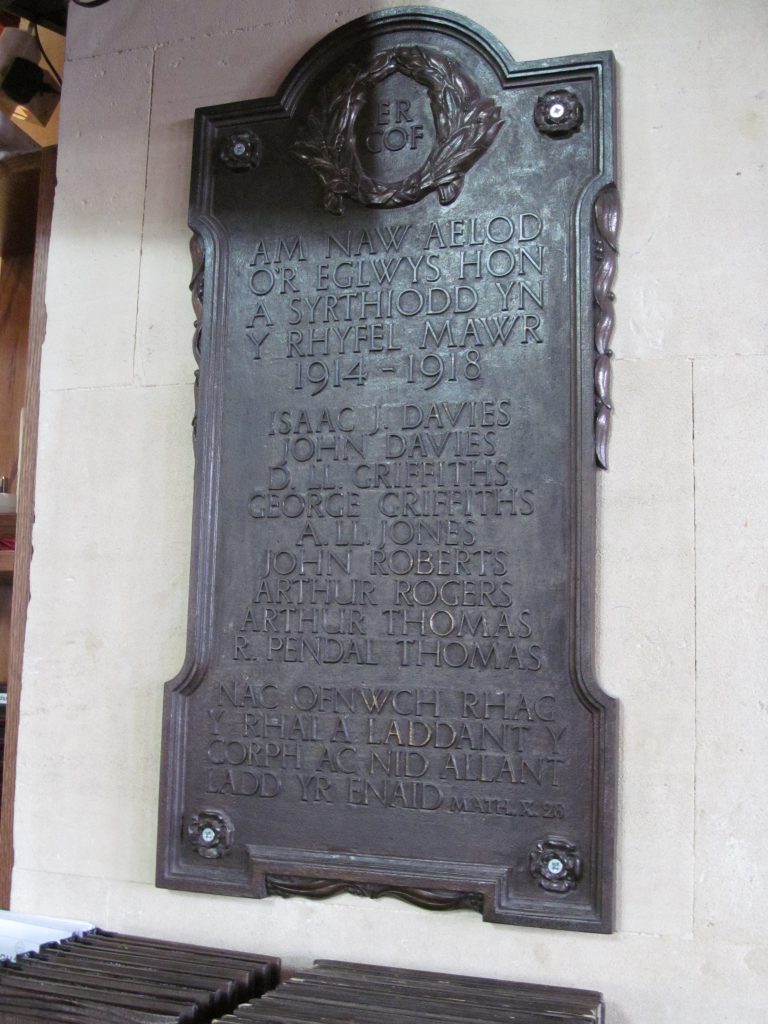 One example where the memorial is still in situ although the building has changed its purpose is in the former Calvinistic Methodist chapel on Pembroke Terrace, now a restaurant known as Chapel 1877. There are nine names on the memorial.
One example where the memorial is still in situ although the building has changed its purpose is in the former Calvinistic Methodist chapel on Pembroke Terrace, now a restaurant known as Chapel 1877. There are nine names on the memorial.
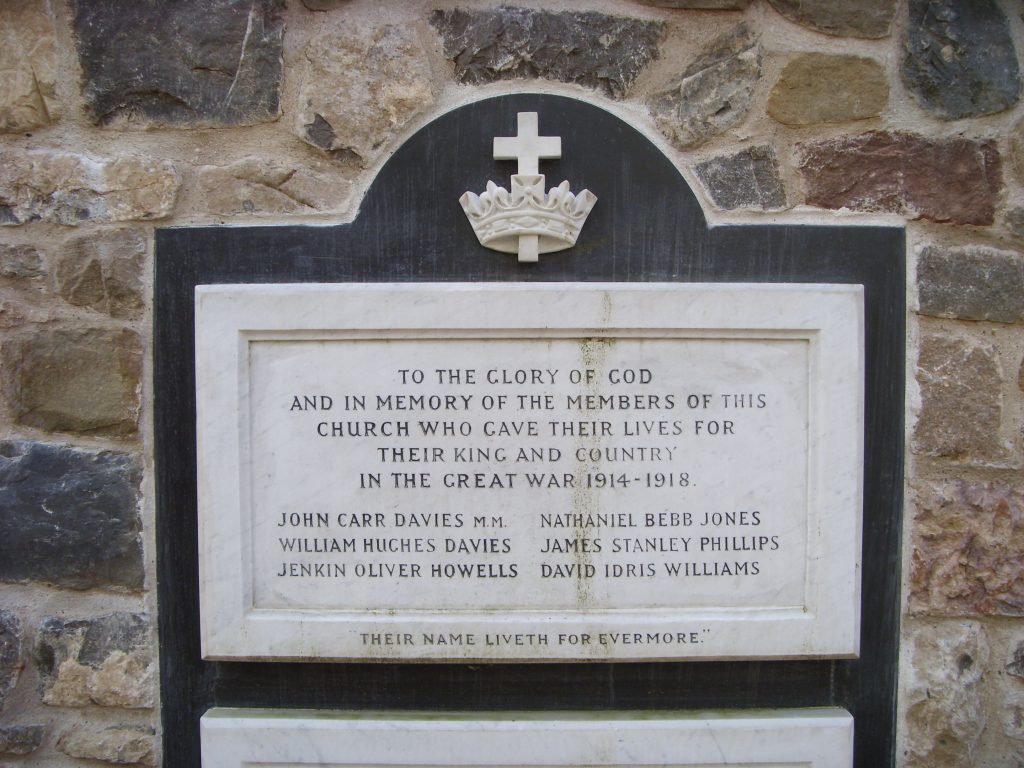 The congregation of Ebenezer (Welsh Independent) used to meet in Charles Street, but now the building is used by the adjacent Catholic church. The stone war memorial, with six names upon it, has been relocated outside.
The congregation of Ebenezer (Welsh Independent) used to meet in Charles Street, but now the building is used by the adjacent Catholic church. The stone war memorial, with six names upon it, has been relocated outside.
Another instance where the memorial has been relocated is to be found in the Trinity Centre, Roath (now an outreach centre of the Methodist church). When the Methodist church nearby in the Broadway closed down in 1950, both the brass memorial (14 names) and the magnificent stained glass windows were moved here.
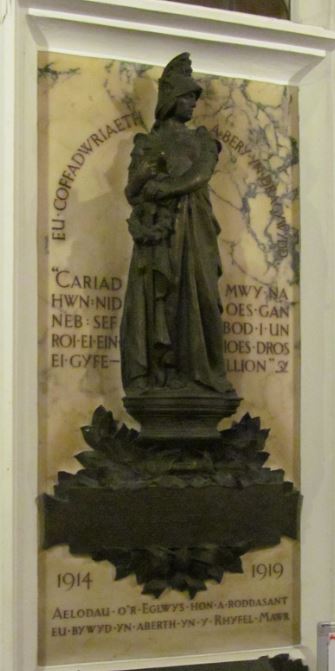 The final war memorial featured in this section is another surprising work of art. Salem (Calvinistic Methodist), Canton, commissioned the famous Cardiff-born sculptor William Goscombe John to create the memorial to the five men of the chapel who died in the war. The result may be a surprise to those who see it today: a statue of a female figure who might represent Britannia or perhaps the Roman goddess Minerva. Either way, it is not what one expects to see in a Welsh chapel!
The final war memorial featured in this section is another surprising work of art. Salem (Calvinistic Methodist), Canton, commissioned the famous Cardiff-born sculptor William Goscombe John to create the memorial to the five men of the chapel who died in the war. The result may be a surprise to those who see it today: a statue of a female figure who might represent Britannia or perhaps the Roman goddess Minerva. Either way, it is not what one expects to see in a Welsh chapel!
Other memorials
Many other clubs or organisations commissioned their own memorials after WW1. It is difficult to estimate how many of these there were, and how many have been lost. For one interesting example, of the Oddfellows’ memorial, now presumed lost, see the Roath Local History Society website
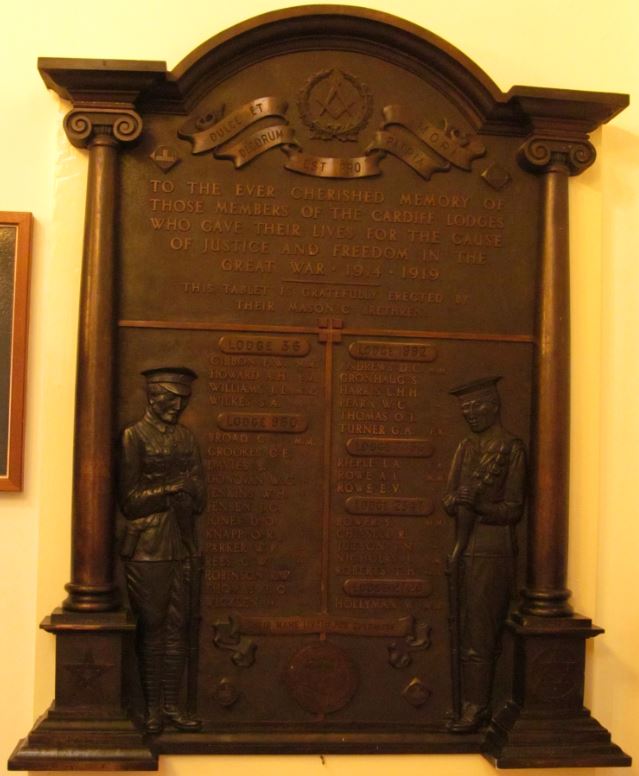 To finish off the list of twenty Cardiff memorials, here is one from the Masonic Hall on Guildford Crescent. This commemorates the men of six different local lodges who died in the war, and names 32 individuals. A Welsh-language resource in which the late Rev Dafydd Henri Edwards describes this memorial is available via the BBC website
To finish off the list of twenty Cardiff memorials, here is one from the Masonic Hall on Guildford Crescent. This commemorates the men of six different local lodges who died in the war, and names 32 individuals. A Welsh-language resource in which the late Rev Dafydd Henri Edwards describes this memorial is available via the BBC website
There are dozens more WW1 memorials in Cardiff. The database of war memorials compiled by the Imperial War Museum lists 102 memorials to the First World War in the city, yet this list is not definitive, and there will be other memorials hidden away across the city which are not yet known to researchers.
Further resources – from the IWM Memorials database:
Cardiff Corporation: https://www.iwm.org.uk/memorials/item/memorial/6647
Cardiff Railway company: https://www.iwm.org.uk/memorials/item/memorial/6670
Taff Vale Railway: https://www.iwm.org.uk/memorials/item/memorial/6669
Cardiff Post Office workers – https://www.iwm.org.uk/memorials/item/memorial/60558
Cardiff Gas Light And Coke Company Grangetown Works: https://www.iwm.org.uk/memorials/item/memorial/6673
Cardiff High School: https://www.iwm.org.uk/memorials/item/memorial/6657
Cardiff University: https://www.iwm.org.uk/memorials/item/memorial/6651
St James’: https://www.iwm.org.uk/memorials/item/memorial/60542
St German’s : https://www.iwm.org.uk/memorials/item/memorial/51037
St Agnes’: https://www.iwm.org.uk/memorials/item/memorial/51030
St Andrew’s United Reformed Church: https://www.iwm.org.uk/memorials/item/memorial/17676
Heath Evangelical: https://www.iwm.org.uk/memorials/item/memorial/37148
Pembroke Terrace: https://www.iwm.org.uk/memorials/item/memorial/65213
Broadway Methodist: https://www.iwm.org.uk/memorials/item/memorial/37643 and https://www.iwm.org.uk/memorials/item/memorial/50427
Cardiff Masonic memorial: https://www.iwm.org.uk/memorials/item/memorial/6675
g.h.matthews May 7th, 2019
Posted In: Uncategorized




